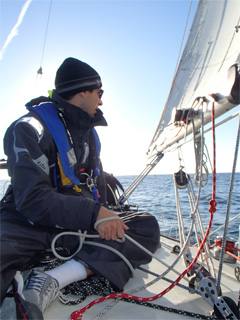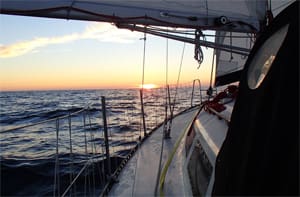To the editor: It was about mid-day when I asked the dockmaster in Jersey City what she had been hearing about weather for the next few days.
Northeast winds were called for of five-to 10-knots. Maybe she said up to 15-knots. Storms? Not in the near future. A high-pressure system was stalled over the region.
I told her our destination. Newport. She suggested we go through Long Island Sound. We told her proudly we would be going out to sea in our C&C 32.
A pause. Then another. “The Sound is going to be more comfortable,” she said evenly.
I thought nothing of it.
Pete Cecinini, 29, a municipal attorney with a burgeoning private practice and a long-time girlfriend, was able to get time off. He was a weekly inshore racer on a competitive Evelyn 26. I had quit my job nearly two months earlier at the age of 35 to prod an office-coddled body and challenge myself in the ocean. I had just returned from a 1,500-nm delivery of a 129-foot tall ship to Puerto Rico.
In each other we found kindred spirits. We wanted an ocean experience, we told each other when we hatched our plan. We did not want the lights of the south shore of Long Island glinting hard in our eyes while to the south the darkness of an enveloping ocean beckoned. Pete, who grew up in light-polluted Jersey City, wanted the stars and brought a sextant.
We wanted unadulterated ocean.
 |
|
Tomas Dinges |
|
Pete Cecinini, rigging the vang during the return trip to New Jersey. |
Thirty hours later, the bow of the C&C 32 surged up and down as four- to six-foot swells from the northeast passed underneath us. The wind was nearing 20 knots. It had been 45 minutes and I was changing the headsail.
The boat had been crashing up, down and along swells since our departure. With autopilot the boat often plunged off of them. Both eating and sleeping were not easy. This was upwind sailing.
Pete had changed the sail out earlier, and tired, failed to notice it wasn’t the working jib labeled on the bag, but it was the smallest of sails, the storm jib. He returned disheartened, but exhilarated.
A pod of dolphins had encircled our slow-moving boat. Some were surfing, three at time, on the waves beside us.
I went forward wearing knee-pads, foul weather gear, and a tether from my PFD to a jackline. I slid into lifelines as the seas pitched the deck beneath me. Hugging the new sail, I released the sail tie and then fed the new working jib into the roller furler foil while grabbing the halyard between my teeth to maintain tension.
It was my third, magnificently clumsy and cautious, but error-filled attempt at changing the headsail. It was my first time double-handing a sailboat in the ocean. It was Pete’s first time that far out.
“Pete, I’m exhausted,” I told him when I returned to the cockpit. “Give me a second.”
My chest heaved. He wanted to tack. I wanted to rest.
We set aside six days in late September for the 170-nm trip to Newport, R.I., from New Jersey and back. We were confident in our ability to fix any problems that arose either in the sail or the engine.
Pete and his father had refitted much of the boat, installing new running rigging, replacing cabin windows, rebedding leaking fittings, replacing the steering cables, and installing an LED masthead navigation light. His father, a commercial fire alarm installer, had put in a Raymarine SeaTalk system, which connected an autopilot system, AIS and radar. He was preparing the boat for a trip to Bermuda next year.
We also had three VHF radios, a personal locator beacon and a handheld Garmin GPS.
What we hadn’t prepared for was that a northeast wind meant that one of our tacks would take us east to Portugal, and the other north to Long Island, and the swell wanted to send us back to New Jersey. I had dismissed without thought the dockmaster’s suggestion. And now we were taking the slow, very rough, course to Newport.
But it was at that moment of the sail change that we realized our vulnerability as double-handed sailors: that no one else would be able to step up when we were tired. Fortunately, these were relatively benign conditions and that this was exactly what we had sought out.
Long Island Sound may have been milder, but certainly meant a horizon of twinkling lights and yellow smudges of nearby towns, and commercial marine traffic.
We got Orion and countless other stars, a yellow moon, frustration and exhaustion, an incredible learning experience, and dolphins.
After beers and hamburgers on Block Island, our new destination after a night of sailing and motoring, we planned our return. Our AIS and radar had failed, the result of water pressing past 30-year-old sealant and causing an electrical short. We rerouted the autopilot connection to get it to function independently of the larger system.
For the return trip to New Jersey, NOAA weather radio told us that northeast winds would prevail. Should we take the ocean?
Definitely.
—Tomas Dinges is a freelance writer and journalist living on the U.S. East Coast.

